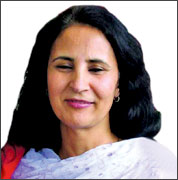Gemidiriya a role model for community development
by Gamini Warushamana
[email protected]
|

Meena Munshi
|
The Gemidiriya Community Development and Livelihood Improvement
Project (GCDLIP) has become a role model since it was initiated four
years ago and the world can learn a lot from Gemidiriya in community
development and poverty alleviation in the rural areas, said World Bank
Regional Coordinator - South Asia Meena Munshi.
Munshi, also the Task Leader of Gemidiriya said, "I never imagined
that Gemidiriya would make such rapid progress and that it will reach
the national level in such a short time span. I felt that Gemidiriya
would take at least eight years to get national recognition".
Munshi said that the Gemidiriya model that has been showing results
would be used in the World Bank funded programs in the future.
"At present we are discussing with the government to use this model
in Gamaneguma and the Eastern province development program. During the
past three months we have made substantial progress in terms of building
a model focusing at village level and take it to Gamaneguma. This model
gives the power to the communities in decision-making on the development
of their villages", she said.
Munshi said that the Gemidiriya model is suitable and will work well
in the Eastern province where the communities want to unite. They have
suffered and they want to come back to their roots and move forward. The
model will work well in the communities where such a model is really
needed.
Munshi recounted the beginning of the Gemidiriya. She said she first
came here in 1998 on a study mission organised by the Bank to learn how
the poor live. "I visited a large number of communities in Sri Lanka and
looked at various models that were introduced by the World Bank, other
donor agencies and the government".
In the interaction with communities I realised that we were not
designing programs from the point of view of communities. All our
development programs are designed from our point of view, our
experience, knowledge and education. We did not see how poor people look
at development. That was a great learning.
For the first time we sat with the communities and found what they
need and designed and implemented a development model for three villages
in the Polonnaruwa district. It was the pilot project called Village
Self Help Learning Initiative (WSHLI).
The principles of this model were designed and implemented by the
poor themselves and we did not force it on them. The whole model was
designed by the communities and that's the reason why it's working. When
we started we only had an idea and we didn't know how to do it. We
facilitated and watched how the communities can graduate economically as
well as in terms of empowerment, she said.
After four years, the WB grant, a part of the project will come to an
end. For the next eight years of the project, the WB will provide a
loan. Munshi said that she is hopeful of the continuation of the
Gemidiriya project for another eight years.
She said that on principle, Gemidiriya and Gamaneguma are similar.
Both programs are based on community participation and giving the power
to them in decision-making and implementation. |
